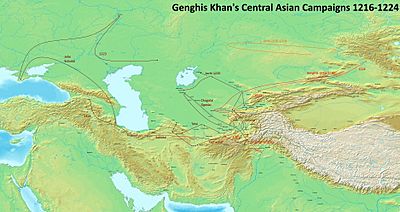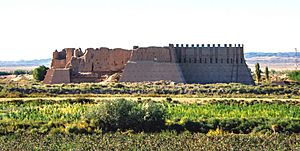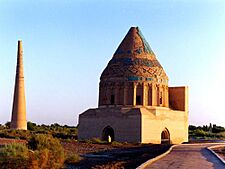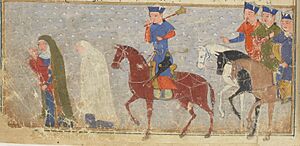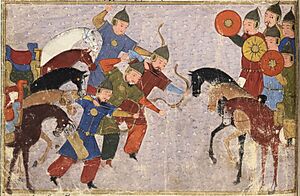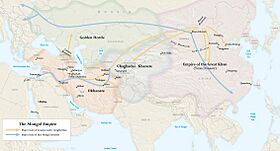Mongol invasion of the Khwarazmian Empire facts for kids
Quick facts for kids Mongol conquest of Khwarezmia |
|||||||||
|---|---|---|---|---|---|---|---|---|---|
| Part of the Mongol invasion of Central Asia and the Mongol invasion of Persia and Mesopotamia | |||||||||
|
|||||||||
| Belligerents | |||||||||
| Mongol Empire | Khwarazmian Empire | ||||||||
| Commanders and leaders | |||||||||
|
|||||||||
| Units involved | |||||||||
|
Predominantly city garrisons | ||||||||
| Strength | |||||||||
|
Disputed (see below). Estimates include:
|
Disputed (see below). Estimates include:
|
||||||||
| Casualties and losses | |||||||||
| Unknown | Possibly as high as 10–15 million people | ||||||||
Between 1219 and 1221, the powerful Mongol Empire led by Genghis Khan invaded the lands of the Khwarazmian Empire in Central Asia. This huge military campaign followed the Mongols' takeover of the Qara Khitai Khanate. The invasion caused widespread destruction and many terrible events. It completed the Mongol conquest of Central Asia and began the Mongol conquest of Persia.
Both empires were quite new. The Khwarazmian dynasty had grown from its home region of Khwarazm to replace the Seljuk Empire in the late 1100s and early 1200s. At the same time, Genghis Khan had united the Mongolic peoples and conquered the Western Xia dynasty. At first, the Mongols and Khwarazmians got along well. However, things changed after a series of diplomatic problems. When a high-ranking Mongol diplomat was killed by Khwarazmshah Muhammed II, Genghis Khan became very angry. He gathered his army, which historians estimate was between 90,000 and 200,000 soldiers, and invaded.
Shah Muhammed II's forces were spread out and likely outnumbered. Knowing this, he decided to defend his cities one by one to slow down the Mongols. But the Mongols, with their excellent organization and planning, were able to surround and conquer the cities of Transoxiana, including Bukhara, Samarkand, and Gurganj. Genghis Khan and his youngest son Tolui then devastated the region of Greater Khorasan. They destroyed important cities like Herat, Nishapur, and Merv. Meanwhile, Muhammed II was chased by the Mongol generals Subutai and Jebe. He couldn't find a safe place and died poor on an island in the Caspian Sea. His son and heir, Jalal-al Din, managed to gather a large army. He even defeated a Mongol general at the Battle of Parwan. But Genghis Khan crushed his forces at the Battle of the Indus a few months later.
After clearing out any remaining resistance, Genghis Khan went back to his war against the Jin dynasty in 1223. This war was one of the deadliest in history, with millions of lives lost. Taking control of the Khwarazmian lands gave the Mongols a base for future attacks on Georgia and the rest of Persia. Later, when the Mongol Empire split, the Persian lands once ruled by the Khwarazmians became part of the Ilkhanate. The northern cities were ruled by the Chagatai Khanate. This campaign was a key moment for the Mongol Empire. It was the first time they fought and defeated a large state that wasn't influenced by Chinese culture.
How the Conflict Started
Central Asia Before the Mongols
In the late 1100s, the main power in Central Asia was the Qara-Khitai Khanate. It was founded in the 1130s. The Khwarazm and the Qarakhanids were technically under Qara-Khitai rule. But because they were large and had many people, they mostly acted on their own. The Qarakhanids were more respected, having ruled for 200 years. They controlled rich cities like Bukhara, Samarkand, Tashkent, and Fergana. Khwarazm, on the other hand, had only one major city, Urgench. It only became important after 1150.
As the Seljuk Empire slowly broke apart after 1154, the Khwarazmids took advantage of the confusion. Il-Arslan's son, Tekish, captured big cities like Nishapur and Merv in Khorāsān. He gained enough power to declare himself a ruler in 1189. Tekish teamed up with the Abbasid caliph Al-Nasir. He defeated the last Seljuk emperor in 1194 and took over the sultanate of Hamadan. Tekish now ruled a huge area from Hamadan in the west to Nishapur in the east. With this new strength, he threatened war with the caliph, who then accepted him as Sultan of Iran and Khorasan in 1198. The fast growth of the Khwarazmian Empire made the Qara-Khitai, their overlords, very unstable. In the early 1200s, the Qara-Khitai became even weaker. This was due to people fleeing from the conquests of Genghis Khan, who was uniting the Mongol tribes.
Muhammad II became the Khwarazmshah after his father Tekish died in 1200. His early rule was difficult, with conflicts against the Ghurids of Afghanistan. But he continued his father's expansion. He conquered the Qarakhanids and took their cities, including Bukhara. In 1211, Kuchlug, a prince from the Naimans, took over the Qara-Khitai empire with Muhammad's help. But Kuchlug made his subjects and the Khwarazmshah angry with his anti-Muslim rules. As a Mongol group led by Jebe hunted him down, Kuchlug ran away. Meanwhile, Muhammad made the areas of Balochistan and Makran his vassals. He also gained the loyalty of the Eldiguzids.
Why Relations Worsened
After their shared enemy Kuchlug was defeated, the Mongols and Khwarazmids initially had good relations. However, Shah Muhammad soon became worried about his new eastern neighbor. Some historians say this change happened because the Shah remembered an earlier, accidental fight with Mongol troops. Their speed and movement had scared him. It's also likely that the Shah had become very proud. Like his father, he was arguing with Caliph Al-Nasir. He even marched an army towards Baghdad, but a snowstorm in the Zagros Mountains stopped him. Some historians think the caliph tried to ally with Genghis Khan, especially as Mongol-Khwarazmid relations got worse. Mongol historians insist that Genghis had no plans to invade Khwarazmia at that time. They say he was only interested in trade and possibly an alliance. They point out that he was already busy with his war against the Jin dynasty in China. He also had to deal with a rebellion in Siberia in 1216.
The Otrar Incident
In 1218, Genghis Khan sent a large group of Mongol merchants to Khwarazmia. It seems many important Mongols had invested in this trip, so they cared a lot about its success. However, Inalchuq, the governor of the Khwarazmian city of Otrar, seized the goods and killed the merchants. He accused them of being spies. Whether the accusations were true, or if the Shah was involved, is debated. But it's certain that the Shah refused Genghis Khan's demands to punish Inalchuq. He even killed one Mongol messenger and shamed two others. This was a huge insult to Genghis Khan himself. He believed that messengers were "sacred and untouchable." Because of this, he stopped his war against the Jin dynasty, leaving only a small army there. He gathered as many men as possible to invade Khwarazmia.
The Armies Involved
How Many Soldiers Fought?
The exact size of each army is much debated. The only sure thing is that the Mongol army was larger than the Shah's. Medieval writers like Rashid al-Din claimed the Mongol army had over 600,000 soldiers. He said they fought against 400,000 Khwarazmians. Another writer, Juzjani, gave an even higher number of 800,000 for the Mongols. Modern historians believe these numbers are greatly exaggerated. The most reliable source from that time is The Secret History of the Mongols. It suggests the Mongol army had between 100,000 and 135,000 soldiers. However, this source might have made the numbers smaller to favor the Mongols.
Some historians think the total Mongol invasion force was no more than 200,000. Others suggest a minimum of 75,000. Most historians estimate the Mongol force to be around 120,000 to 130,000. It's hard to be certain because the Mongol army was very flexible and efficient. It could split up and come back together easily. For the Khwarazmians, there isn't a reliable source like the Secret History. One estimate suggests they had about 40,000 soldiers, not counting some city militias. Another historian gives a much larger figure of 200,000.
Shah Muhammad's Challenges
The Khwarazmshah faced many problems. His empire was huge and newly formed, with a government still being set up. In 1218, he had changed the old government system, creating a new, loyal one. This ongoing change might have caused confusion during the Mongol invasion. Also, his mother, Terken Khatun, still had a lot of power. One historian called their relationship an "uneasy shared rule," which often worked against Muhammad.
Many areas Muhammad told his troops to defend had recently been damaged by Khwarazmian forces. When he passed through Nishapur later, he urged citizens to fix the walls his father had broken. Bukhara had been attacked by Muhammad himself only eight years earlier, in 1212. The Shah also didn't trust most of his commanders. The only exception was his oldest son and heir, Jalal al-Din. Jalal al-Din's military skills had been very important in a battle the year before. If Muhammad had chosen to fight an open battle, as many of his commanders wanted, he would have been greatly outnumbered and outmatched. So, the Shah decided to spread his forces out as defenders inside his most important towns, like Samarkand, Merv, and Nishapur.
Genghis Khan's army was led by his best generals, except for Muqali, who stayed behind to continue the war against the Jin dynasty. Genghis also brought many Chinese experts in siege warfare and construction. These included Chinese who knew about gunpowder. Historians believe the Mongol invasion brought Chinese gunpowder weapons, like the huochong, to Central Asia.
The Mongol Campaign Begins
Early Moves and the Siege of Otrar
The Khwarazm Shah and his advisors thought the Mongols would invade through the Dzungarian Gate. This was a natural mountain pass between the conquered Qara-Khitai and Khwarazm Empires. One defense plan for Khwarazm was to go beyond the Syr Darya towns and block the Dzungarian Gate with an army. This was because it would take Genghis many months to gather his army in Mongolia and march through the pass after winter.
However, a Mongol force led by Chagatai and Ogedei soon arrived at Otrar. They came from either the Altai Mountains to the north or the Dzungarian Gate. They immediately began to besiege the city. One writer said Otrar had 20,000 defenders, while another claimed 60,000. But like most numbers in medieval writings, these are probably much too high for the city's size.
Unlike most other cities, Otrar did not surrender quickly. Its governor also did not lead his army out to fight the larger Mongol force. Instead, the defenders stayed on the walls and fought bravely, holding out against many attacks. The siege lasted five months with no success for the Mongols. Then, a traitor inside the city, who didn't feel loyal to the Shah or Inalchuq, opened the gates to the Mongols. The Mongol forces stormed the now open gate and killed most of the defenders. The citadel, which held the remaining tenth of the defenders, held out for another month. It was only taken after the Mongols suffered many losses. Inalchuq fought until the very end. In the last moments of the siege, he even climbed to the top of the citadel to throw tiles at the Mongols and kill many in close combat. Genghis Khan killed many of the city's people, enslaved the rest, and executed Inalchuq.
The Fall of Bukhara
At this point, the Mongol army was split into five groups, far apart from each other. Since the Shah didn't actively defend the cities along the Syr Darya river, Genghis and Tolui, with about 50,000 men, went around the natural defenses of the Syr Darya. They traveled west to attack the city of Bukhara first. To do this, they crossed 300 miles of the seemingly impossible Kyzyl Kum desert. They moved from one oasis to another, guided by captured nomads. The Mongols arrived at Bukhara's gates almost unnoticed. Many military experts consider this surprise attack on Bukhara one of the most successful moves in warfare.
Bukhara was not heavily fortified. It had a moat and a single wall, plus a citadel, which was common in Khwarazmian cities. The Bukhara defenders were Turkic soldiers led by Turkic generals. They tried to break out on the third day of the siege. Some writers say the city had 20,000 defenders, but one historian thinks it was only a tenth of that number. The group that tried to break out was completely destroyed in open battle. The city's leaders then opened the gates to the Mongols. However, a group of Turkic defenders held the city's citadel for another twelve days. The Mongols highly valued the skills of artisans. Artisans were saved from mass killings and instead became lifelong slaves. So, when the citadel was taken, all survivors were killed except for artisans and craftsmen, who were sent back to Mongolia. Young men who had not fought were forced into the Mongolian army, and the rest of the people were enslaved. As the Mongol soldiers looted the city, a fire started, burning most of it to the ground.
Samarkand's Surrender
After Bukhara fell, Genghis Khan went to Samarkand, the Khwarazmian capital, arriving in March 1220. During this time, the Mongols also used clever psychological warfare to cause problems among their enemies. The Khan's spies learned about the bitter arguments between the Shah and his mother, Terken Khatun. She had the loyalty of some of his top commanders and elite Turkish cavalry. Since Mongols and Turks were both steppe peoples, Genghis suggested that Terken Khatun and her army should join the Mongols against her "treacherous" son. Meanwhile, he arranged for deserters to carry letters saying Terken Khatun and some of her generals had allied with the Mongols. This made the existing divisions in the Khwarazm Empire even worse. It likely stopped the senior commanders from uniting their forces. Genghis then made things worse by repeatedly issuing fake orders in the name of either Terken Khatun or Shah Mohammed. This further confused the already divided Khwarazm command. As a result of the Mongol's smart plans, fast movements, and mind games, all the Khwarazm generals, including the Queen Mother, kept their forces in their cities and were defeated one by one.
Samarkand had much better defenses and a larger group of defenders than Bukhara. Some writers say the city's defenders numbered 100,000–110,000 men, while another states 50,000. A more realistic number might be 10,000, considering the city itself had fewer than 100,000 people at the time. As Genghis began his siege, his sons Chaghatai and Ögedei joined him after finishing the attack on Otrar. The combined Mongol forces then launched an assault on Samarkand. The Mongols attacked using prisoners as human shields. On the third day of fighting, the Samarkand defenders launched a counterattack. Genghis pretended to retreat, drawing about half of the defenders outside the city's walls. He then slaughtered them in open combat. Shah Muhammad tried to help the city twice but was pushed back. On the fifth day, almost all the soldiers surrendered. The remaining soldiers, who were very loyal to the Shah, held out in the citadel. After the fortress fell, Genghis broke his promise of surrender terms and executed every soldier who had fought against him at Samarkand. The people of Samarkand were ordered to leave the city and gather on a plain outside, where many were killed.
Around the time Samarkand fell, Genghis Khan ordered Subutai and Jebe, two of his best generals, to hunt down the Shah. The Shah had fled west with some of his most loyal soldiers and his son, Jalal al-Din, to a small island in the Caspian Sea. It was there, in December 1220, that the Shah died. Most scholars believe he died from pneumonia, but others say it was from the sudden shock of losing his empire.
The Difficult Siege of Gurganj
Meanwhile, the rich trading city of Gurganj was still controlled by Khwarazmian forces. Earlier, the Shah's mother had ruled Gurganj, but she fled when she learned her son had gone to the Caspian Sea. She was captured and sent to Mongolia. Khumar Tegin, one of Muhammad's generals, declared himself Sultan of Gurganj. Jochi, who had been fighting in the north since the invasion began, approached the city from that direction. Genghis, Ögedei, and Chaghatai attacked from the south.
The attack on Gurganj turned out to be the hardest battle of the Mongol invasion. The city was built along the Amu Darya river in a marshy, wet area. The soft ground made siege warfare difficult, and there weren't many large stones for the catapults. The Mongols attacked anyway, and the city fell only after the defenders fought very bravely, street by street. Mongol casualties were higher than usual because they weren't used to fighting in cities.
Taking Gurganj was made even harder by ongoing tensions between Genghis Khan and his oldest son, Jochi. Jochi had been promised the city as his reward. Jochi's mother was Börte, Genghis Khan's first wife and lifelong love. Only her sons were considered Genghis's "official" sons and future rulers. But Jochi's birth was controversial; in the early days of Genghis Khan's rise, Börte was captured. Her son Jochi was born nine months later. While Genghis Khan chose to accept him as his oldest son (mostly because of his love for Börte), questions about Jochi's true father had always existed.
These tensions were clear as Jochi negotiated with the defenders, trying to get them to surrender so that as much of the city as possible would be unharmed. This angered Chaghatai. Genghis stopped this fight between his sons by making Ögedei the commander of the attacking forces as Gurganj fell. But removing Jochi from command, and the destruction of a city he thought was promised to him, made him furious. This created a rift between him and his father and brothers. Many believe this was a key reason for Jochi's later actions, as he saw his younger brothers promoted over him despite his own great military skills.
As usual, the artisans were sent back to Mongolia. Young women and children were given to the Mongol soldiers as slaves. The rest of the people were killed. One Persian scholar wrote that 50,000 Mongol soldiers were ordered to kill twenty-four Gurganj citizens each, which would mean 1.2 million people were killed. While this is almost certainly an exaggeration, the destruction of Gurganj is considered one of the bloodiest massacres in human history. After its surrender, the Mongols broke the dams and flooded the city, then killed the survivors.
The Campaign in Khorasan
While the Mongols were fighting their way into Urgench, Genghis Khan sent his youngest son Tolui, with an army, into the western Khwarazmid province of Khorasan. Khorasan had already felt the Mongols' power. Earlier in the war, generals Jebe and Subutai had traveled through the province while chasing the fleeing Shah. However, the region was far from fully conquered. Many major cities were still free of Mongol rule. The region was full of rebellions against the few Mongol forces there, following rumors that the Shah's son Jalal al-Din was gathering an army to fight the Mongols.
Tolui's army had around 50,000 men. This included a core of Mongol soldiers (some estimate 7,000) and many foreign soldiers, such as Turks and people from conquered areas in China and Mongolia. The army also had "3,000 machines for throwing heavy flaming arrows, 300 catapults, 700 mangonels to throw pots filled with naphtha (a flammable liquid), 4,000 storming ladders, and 2,500 sacks of earth for filling up moats." Among the first cities to fall were Termez and then Balkh.
The most important city to fall to Tolui's army was Merv. One writer described Merv as: "In size, it was the best among the lands of Khorasan, and peace and safety covered its borders. Its important people were as many as the drops of April rain, and its land competed with the heavens." The defenders at Merv were only about 12,000 men, and the city was filled with refugees from eastern Khwarazmia. For six days, Tolui besieged the city. On the seventh day, he attacked. However, the defenders pushed back the attack and launched their own counter-attack against the Mongols. This group of defenders was also forced back into the city. The next day, the city's governor surrendered the city. Tolui had promised that the citizens' lives would be spared. But as soon as the city was handed over, Tolui killed almost everyone who surrendered. This massacre was possibly even larger than the one at Urgench.
After finishing with Merv, Tolui headed west, attacking the cities of Nishapur and Herat. Nishapur fell after only three days. Here, Tokuchar, a son-in-law of Genghis, was killed in battle. Tolui then killed every living thing in the city. After Nishapur's fall, Herat surrendered without a fight and was spared.
Bamiyan in the Hindu Kush mountains was another place of great killing. Strong resistance there led to the death of a grandson of Genghis. Next was the city of Toos. By spring 1221, the province of Khurasan was completely under Mongol rule. Leaving small groups of soldiers behind, Tolui headed back east to rejoin his father.
Jalal al-Din's Resistance
After the Mongol campaign in Khorasan, the Shah's army was broken. Jalal al-Din, who became ruler after his father's death, began gathering the remaining Khwarazmid soldiers in the south, in Afghanistan. Genghis had sent forces to hunt down Jalal al-Din's growing army. The two sides met in September 1221 at the town of Parwan. This battle was a humiliating defeat for the Mongol forces. Enraged, Genghis went south himself and defeated Jalal al-Din on the Indus River. Jalal al-Din, defeated, fled to India. Genghis spent some time on the southern shore of the Indus looking for the new Shah, but he couldn't find him.
Genghis sent Dorbei Doqshin with two tumens (Mongol army units) to chase Jalal al-Din in early 1222, as he still saw him as a threat. One story says Doqshin failed to capture al-Din and returned to Genghis Khan in Samarkand. Genghis was so angry that he sent Doqshin out again immediately on the same task. Meanwhile, al-Din was arguing with local princes, but he mostly won his battles. Under Doqshin's leadership, the Mongol army took Nandana from one of Jalal al-Din's officers, looted it, and then besieged the larger city of Multan. The Mongol army managed to break through the wall, but the Khwarazmians successfully defended the city. Because of the hot weather, the Mongols had to retreat after 42 days.
Encouraged by Jalal al-Din's success against the Mongols, the Khwarazmians started a rebellion. Kush Tegin Pahlawan led a revolt in Merv and successfully took it. After recapturing Merv, Kush Tegin Pahlawan successfully attacked Bukhara. People in Herat also rebelled and removed the Mongol-appointed leaders. A rebel leader named Muhammad the Marghani twice attacked Genghis Khan's camp at Baghlan and returned with some loot. In response, Genghis Khan sent a large army under Ögedei Khan back to Ghazni. Genghis Khan appointed Yelü Ahai to restore Mongol control in Samarkand and Bukhara, which he did in 1223. Shikhikhutug dealt with the revolt that removed the pro-Mongol government of Merv.
What Happened Next
After defeating the Khwarazmian Empire, Genghis Khan gathered his forces in Persia and Armenia to return to the Mongolian steppes. Following a suggestion from Subutai, the Mongol army was split into two groups. Genghis Khan led the main army on a raid through Afghanistan and northern India towards Mongolia. Another group of 20,000 soldiers marched through the Caucasus and into Russia, Armenia, and Azerbaijan under generals Jebe and Subutai.
In the years that followed, Jalal al-Din tried to rebuild the Khwarazm kingdom. But he never fully gained strong control. He retook parts of western Iran, in Kerman, Tabriz, Isfahan, and Fars. However, he was eventually defeated by the Rum Seljuk Sultan Kayqubad I at the Battle of Yassıçemen in 1230. The Mongols returned to conquer the western areas of the former Khwarazmian Empire in 1230–1231. This was during the rule of Genghis Khan's successor, Ögedei, who sent an expedition led by general Chormaghun. After trying to defend, Jalal al-Din finally died in Diyarbakir in 1231. The Mongols under Chormaghun settled in northwestern Iran. From there, they could raid nearby areas like Armenia, Azerbaijan, and Mosul over the next ten years. This led to the invasion of Georgia in 1236.
The destruction and takeover of the Khwarazmid Empire showed what was to come for the Islamic world and for Eastern Europe. This new territory became an important starting point for the Mongol armies when they invaded Kievan Rus' and Poland during the reign of Genghis's son Ögedei. Future campaigns brought Mongol armies to Hungary and the Baltic Sea. For the Islamic world, the fall of Khwarazmia left Iraq, Turkey, and Syria open to attack. All three regions were later conquered by future Mongol Khans.
The war with Khwarazmia also brought up the important question of who would rule next. Genghis was not young when the war began. He had four sons, all fierce warriors, and each had their own loyal followers. Their rivalry almost caused a major problem during the siege of Urgench. Genghis had to rely on his third son, Ögedei, to finish the battle. After the destruction of Urgench, Genghis officially chose Ögedei to be his successor. He also decided that future Khans would be direct descendants of previous rulers. Despite Genghis setting this rule, his four sons would eventually fight among themselves. These conflicts showed how unstable the empire Genghis had created could be.
Jochi never forgave his father. He mostly stayed out of future Mongol wars. He moved to the north and refused to come to his father when ordered. In fact, at the time of his death, Genghis Khan was thinking about marching against his rebellious son. The bitterness from this event was passed down to Jochi's sons, especially Batu and Berke Khan (of the Golden Horde), who would conquer Kievan Rus. When the Mamluks of Egypt managed to defeat the Mongols at the Battle of Ain Jalut in 1260, Hulagu Khan, one of Genghis Khan's grandsons (through his son Tolui), who had destroyed Baghdad in 1258, could not get revenge for that defeat. This was because Berke Khan, his cousin (who had converted to Islam), attacked him in the Transcaucasus to help the cause of Islam. This was the first time Mongol fought Mongol. The reasons for that battle began in the conflict with Khwarazmia, when their fathers struggled for power.
|




